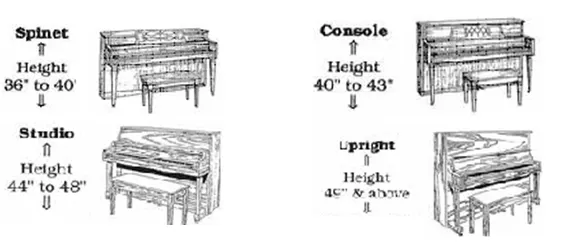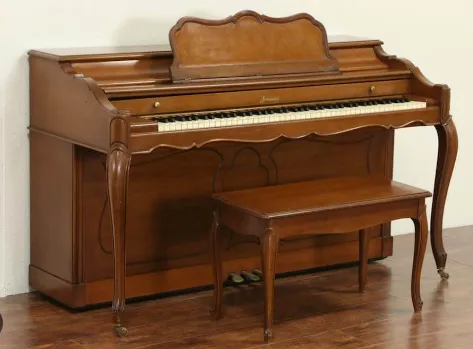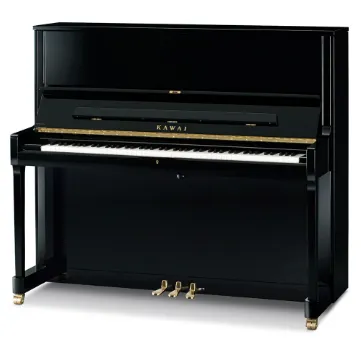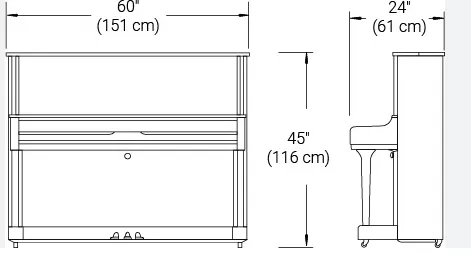How Tall Is An Upright Piano: Types & Dimensions
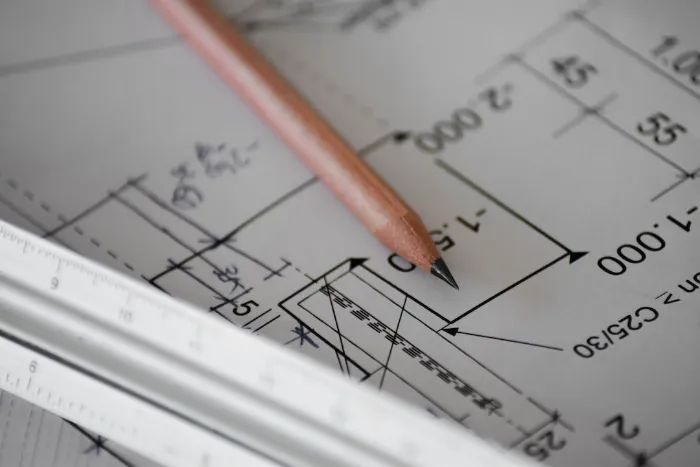
What are the Sizes of Upright Pianos?
Upright pianos, also known as vertical pianos, come in various heights, widths, and depths. Generally, the biggest difference is their height as opposed to the area they take up on the floor.
They are the most popular choice of pianos used in homes, schools, churches, and music studios. Modern upright pianos are made with specific woods to differentiate a piano in-home vs. on-stage.
Upright pianos come in different models, such as spinets, console pianos, studio uprights, and standard upright pianos. Nowadays, pianos aren’t produced smaller than console pianos.
Each size was uniquely created to satisfy the specific needs of the pianist. Predominantly, however, the size and shape of upright pianos were determined by consumer market demands, instead of artistic tastes.
In this blog, we are going to focus on the piano height, width, and depth of all upright pianos – all being essential factors that determines the piano's tonal quality, playability, and most importantly, the space it will occupy in your room.
What’s the smallest piano?
A Spinet. Spinets are no longer made! They are primarily used as a decoration in many homes across the U.S.
Article - Why A Spinet Piano is Different than Upright Pianos
Firstly, let's take a look at the smallest vertical pianos, which are Spinets. These types of pianos are known for their ornate furniture designs, often kept for their decorative value.
Spinet pianos are the smallest types of pianos and measure between 35 to 40 inches in height. They’re hardly any taller than 3 feet tall!
These small pianos must use an indirect blow action due to the smaller size of its cabinet, which is considered to be of lesser quality compared with full size actions and make it impossible to correctly play through difficult passages.
While they often are the most affordable upright piano option, the downside of spinets is the quality of the sound. It sounds more like a toy than a professional instrument when played.
Upright acoustic pianos that are shorter than 43 inches are designed for small spaces and as a result of their small size produce a sound that lacks richness of tone. On the bright side, spinet owners love them for how they look in the living room.
Taller models can create more harmonic overtones, making them ideal for larger rooms or professional spaces.
Spinets are no more than 40 inches tall and are ideal for those with extremely limited space, and those who will mostly be enjoying it as a decorative piece of furniture rather than a musical instrument for home use.
What’s bigger than a spinet?
A Console. Consoles are certainly an upgrade from spinets.
Article - Console Pianos Vs. Upright Pianos: Which is Better for You?
The next size is the console piano that is slightly bigger, measuring between 40 to 44 inches in height. They’re just over 3.5 feet tall!
These pianos have the action of a console, which means it is a non-drop action mechanism that Spinets have. This means that the actions are better than their spinet counterparts.
The larger action produces a more robust feel which only gets better as piano dimensions become larger. The intertia of the key becomes greater, which makes it easier to play challenging pieces.
The extra height and larger soundboard allow for longer strings, giving the console a good quality sound. At this size, every extra inch of height matters, as it corresponds to the quality of the instrument in general.
Although a little larger than spinets, they are still a popular choice of many people, relatively compact, and suitable for smaller spaces. I recommend a small console over a spinet any day of the week!
What’s a good sized upright piano?
Studio. A studio upright is where quality begins to balance within the limited space of smaller pianos.
Studio pianos are the second smallest and range between 44 to 48 inches in height. That’s about 4 feet tall!
They have high quality sound and have what experts can agree is a full-size action. Full sized actions help piano players perform difficult passages more easily.
These pianos are designed for advanced players who require a high-quality instrument to train on. Higher quality instruments make it accessible for beginners to perform well.
Studios have longer strings than the two previous types, producing a crisper, cleaner sound with more dynamic range due to a large soundboard.
The larger size also means that more complex pieces can be played with ease namely due to the full size action and better sound.
Studios need a bigger floor space and are intended for larger rooms, music halls, or performance venues.
What’s a regular sized upright piano?
Standard Upright Piano. The standard upright piano is a great choice for any piano beginner.
The second tallest type of upright piano stands at around 48 inches and above. It's the standard upright piano.
Tall upright pianos are also the most expensive upright piano option due to their size, quality of sound, and craftsmanship.
They are favored by at home pianists and professional musicians who want the richest and most authentic sound possible that is simply not possible in smaller pianos.
The length of the strings and size of the soundboard allows for the highest quality of sound and resonance.
The full upright piano action sacrifices nothing due to size making it a professional piano.
What's the size of a Concert upright?
A Concert sized upright is 52" tall. That's about 4.5 feet tall!
Concert uprights don't sacrifice quality of sound, touch, or materials used to produce each piano.
High quality uprights such as concert verticals are ideal for many skilled pianists.
How deep are pianos, depth wise?
Other Dimensions - Depth
Another dimension you should consider when looking at an upright piano is its depth.
This measurement gives the piano extra room to resonate within the cabinet of the piano.
Spinet, Console, Studio and Upright pianos have a standard depth of 2 feet to 2 1/2 feet.
Like other dimensions, the depth of an upright piano varies by model and manufacturer.
On average, most upright pianos have a depth of between 25 and 30 inches.
How wide are pianos?
Other Dimensions - Width
Ready My Article: How wide are pianos: Grand and Upright Dimensions
When it comes to the width of an upright piano, it is consistent across all categories.
Upright pianos are standardized and measure approximately 60 inches in width.
This measurement allows them to fit through doorways and into most spaces easily.
The width of an upright piano largely depends on the brand and model.
Generally, upright pianos measure between 55 and 60 inches in width.
The fewer keys on your piano will also affect the width, making it proportionally smaller with each key.
A standard upright piano with 88 keys is equally wide as a grand piano in terms of keyboard width.
How much do pianos weigh?
Other Dimensions - Weight
Read My Article: How Much Does a Piano Weigh? Grand and Upright Piano weight in lbs.
In terms of weight, heaviness varies significantly with different piano types and sizes.
Keep in mind that if you don’t move the piano, it will never come to mind how much your piano weighs and won’t really matter so long as you have good wheels on the piano.
This is also to say that having bad piano wheels will make it extremely difficult to move the piano even a few inches.
What are the dimensions and weights of upright pianos?
A spinet piano between 36-40” tall can weigh between 200 to 400 lbs(91-181kg).
Console pianos between 40-43” tall can weigh between 350 to 450 lbs(159-204kg).
Studio Pianos between 44-48” tall can weigh between 400-500 lbs(181-227kg).
A Standard upright piano between 48-60” tall can weigh between 500-1000 lbs(227-454kg).
It’s always a good idea to hire a piano mover when moving a piano to a new home, up or down stairs, or even to the other side of a room as injuries are common for those who do not have experience moving pianos.
Conclusion:
Understanding the main differences about the size dimensions, weight, and model of an upright piano are crucial when looking at pianos with a comparative lens.
The primary size dimension to consider is height.
The height of a piano is the largest factor when judging the quality of sound produced, playability, and overall quality.
Upright pianos' widths and depths are standardized, making them easy to maneuver and fit into most rooms.
Another factor to take into account when comparing between different pianos is the weight of the instrument.
Weight can vary depending on the size of the instrument and get dramatically heavier for the largest upright pianos.
Another important element are the varying types of models which include Spinets, Consoles, Studios, and Standard Upright Pianos.
Different model pianos have pros and cons that affect the sound, playability, and overall quality of the instrument.
Each size has its unique advantages, no detail is too insignificant when considering all the subtleties that make each piano unique.
We hope this comprehensive blog on the size of upright pianos has helped you better understand the different height, width, depth, and weight dimensions of the different types of upright pianos.
